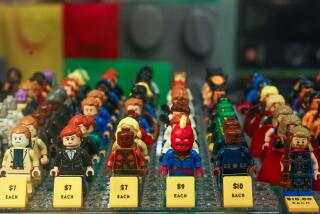The Times 100 : The Best Performing Companies in California : THE BOTTOM LINE : Lewis Galoob Toys Makes a Big Comeback on Micro Machines
- Share via
The toy business is anything but fun and games.
Just ask Lewis Galoob Toys, whose Baby Talk and Mr. Gameshow talking dolls were no match for the Nintendo revolution.
But that was three years ago.
Riding the tiny wheels of its Micro Machines line of miniature cars, Lewis Galoob Toys has roared back from a loss of nearly $25 million in 1987.
The South San Francisco firm reported 1989 net income of $19.6 million on sales of $227.7 million, compared to 1988’s income of $6.6 million and sales of $140.1 million. The company has made its first appearance on The Times 100 list of the most profitable companies in California, ranking No. 4 with a two-year average return on equity of 45.7%.
Galoob “is definitely one of the hot companies in the toy industry,” said Larry Carlat, editor of Toy and Hobby World magazine, a trade publication. “For the last two years they have done very, very well.”
Galoob’s performance is particularly impressive because it “comes at a time when most of the toy industry is kind of flat,” Carlat said.
However, some analysts worry about Galoob’s heavy dependence on one toy line in a volatile industry that depends on the whims of a bunch of consumers with short attention spans.
In search of diversification, Galoob said more than a year ago that it was interested in buying a company to provide “a more stable, non-promotional product base.” Rumors of potential purchases have come and gone, but Galoob has yet to make an acquisition.
No Galoob executive could be reached for comment for this story.
Lewis Galoob Toys, which was founded in 1957 as an importer by the parents of Chief Executive David Galoob, has grown in recent years to become one of the nation’s largest independent publicly held toy companies by developing its own toy ideas, which are then manufactured overseas. Before 1985, the company specialized in licensed toys, such as a Mr. T doll.
(Lewis Galoob died nearly 20 years ago. Barbara Galoob Frankel retired as chairman in 1988.)
1987 brought an industrywide slump, broken only by the extraordinary success of the Nintendo video game system. Consumers weren’t interested in the industry’s offerings that year, which was marked by the introduction of several electronics-packed talking dolls--some that could even converse with each other.
In addition, Galoob had trouble meeting what demand there was because of manufacturing problems and delays in the Far East factories making its high-tech toys. The company estimated that delays cost it $15 million to $20 million in orders, which resulted in layoffs. It ultimately posted a $24.8-million net loss in 1987.
But Galoob reached into its toy chest and pulled out Micro Machines, a line of collectible cars that are much smaller than Mattel Hot Wheels and Universal Matchbox cars, both old favorites. The size and the low price tag were a big hit with the small set and by 1989 accounted for about 74% of Galoob’s sales.
Galoob’s other top product is Bouncin’ Babies, a line of battery-operated dolls. Carlat said Micro Machines parked on Toy and Hobby World’s list of the 10 best-selling toys last year and even cruised into the top five for a while. Bouncin’ Babies stayed in the top 20 all year, he said.
The dependence on toy lines that may be peaking is Galoob’s “Achilles’ heel,” Carlat said. “The problem is how do they make up that volume?”
Some of the company’s new toys, which won’t get their first real test until the Christmas selling season, include sad-looking stuffed animals that cry real tears, plush dogs whose eyes light up when the toy is squeezed, miniature dolls that come with rooms of tiny furniture and Mandi, a doll that talks, sings and even eats.
The 1990 line is “by far the largest and most diverse in the company’s history,” David Galoob told shareholders in a November letter. Lewis Galoob Toys has achieved “the strongest posture in its history from both a marketing and a financial perspective and . . . (is poised) to move into the 1990s as one of the industry’s leaders,” he said.
More to Read
Inside the business of entertainment
The Wide Shot brings you news, analysis and insights on everything from streaming wars to production — and what it all means for the future.
You may occasionally receive promotional content from the Los Angeles Times.










